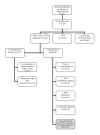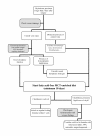Chylothorax after surgery on congenital heart disease in newborns and infants -risk factors and efficacy of MCT-diet
- PMID: 21144029
- PMCID: PMC3009966
- DOI: 10.1186/1749-8090-5-127
Chylothorax after surgery on congenital heart disease in newborns and infants -risk factors and efficacy of MCT-diet
Abstract
Objectives: To analyze risk factors for chylothorax in infants after congenital heart surgery and the efficacy of median chain triglyceride diet (MCT). To develop our therapeutic pathway for the management of chylothorax.
Patients and methods: Retrospective review of the institutional surgical database and patient charts including detailed perioperative informations between 1/2000 and 10/2006. Data analyzing with an elimination regression analysis.
Results: Twenty six out of 282 patients had chylothorax (=9.2%). Secondary chest closure, low body weight, small size, longer cardiopulmonary bypass (242 ± 30 versus 129 ± 5 min) and x-clamp times (111 ± 15 versus 62 ± 3 min) were significantly associated with chylothorax (p < 0.05). One patient was cured with total parenteral nutrition (TPN) and one without any treatment. 24 patients received MCT-diet alone, which was successful in 17 patients within 10 days. After conversion to regular alimentation within one week only one chylothorax relapsed. Out of 7 patients primarily not responsive to MCT-diet, 2 were successfully treated by lysis of a caval vein thrombosis, 2 by TPN + pleurodesis + supradiaphragmatic thoracic duct ligation, one by octreotide treatment, and two patients finally died.
Conclusions: Chylothorax may appear due to injury of the thoracic duct, due to venous or lymphatic congestion, central vein thrombosis, or diffuse injury of mediastinal lymphatic tissue in association with secondary chest closure. Application of MCT alone was effective in 71%, and more invasive treatments like TPN should not be used in primary routine. After resolution of chylothorax, MCT-diet can be converted to regular milk formula within one week and with very low risk of relapse.
Figures


References
MeSH terms
Substances
LinkOut - more resources
Full Text Sources
Medical
Research Materials

